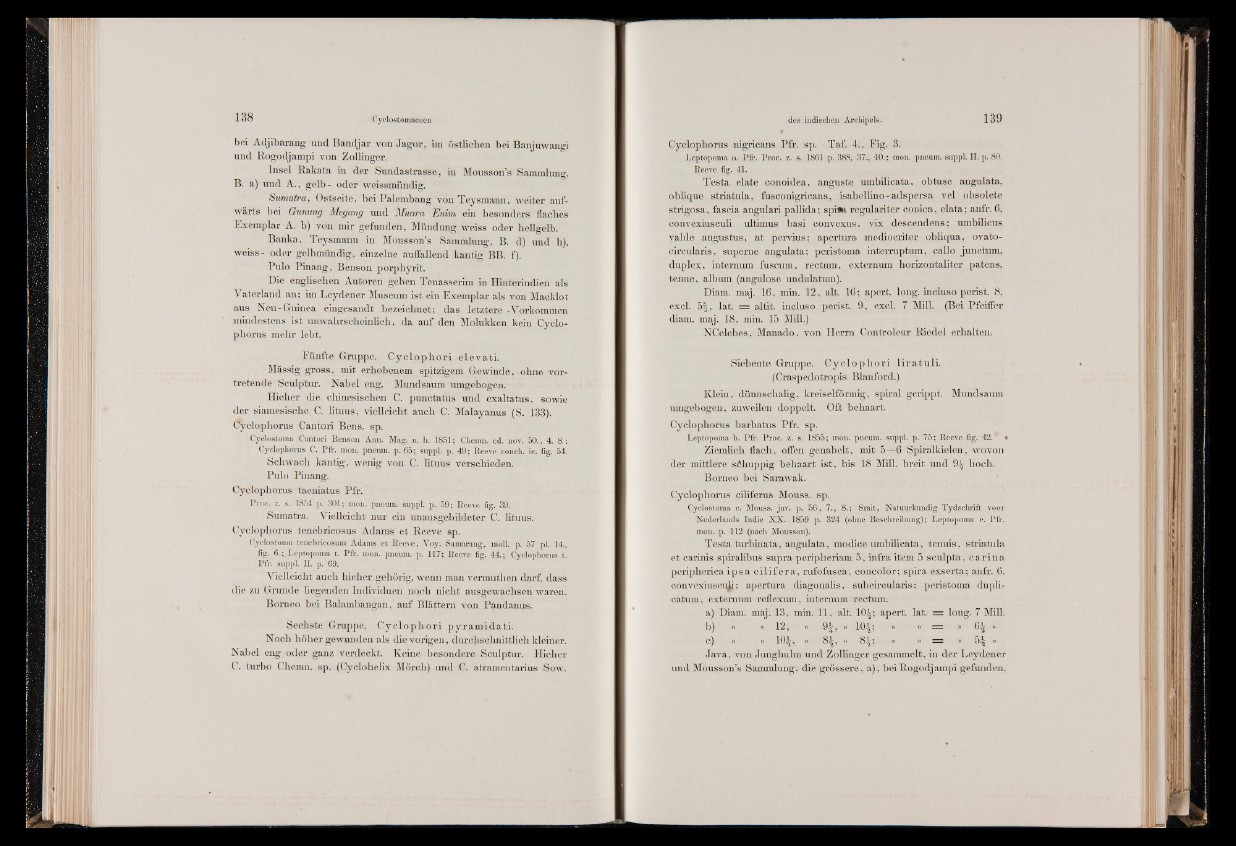
bei Adjibarang und Bandjar von Jagor, im östlichen bei Banjuwangi
und Rogodjampi von Zollinger.
Insel Rakata in der Sundastrasse, in Mousson’s Samnüung,
B. a) und A., gelb- oder weissmündig.
Sumatra, Ostseite, bei Palembang vonTeysmann, weiter aufwärts
bei Gunung Megang und Muara Enim ein besonders flaches
Exemplar A. b) von mir gefunden, Mündung weiss oder hellgelb.
Banka, Teysmann in Mousson’s Sammlung, B. d) und h),
weiss- oder gelbmündig, einzelne auffallend kantig BB. f).
Pulo Pinang, Benson porphyrit.
Die englischen Autoren geben Tenasserim in Hinterindien als
Vaterland an; im Leydener Museum ist ein Exemplar als von Macklot
aus Neu-Guinea eingesandt bezeichnet; das letztere -Vorkommen
mindestens ist unwahrscheinlich, da auf den Molukken kein Cyclo-
phorus mehr lebt.
Fünfte Gruppe. C y c lo p h o r i e le v a ti.
Massig gross, mit erhobenem spitzigem Gewinde, ohne vortretende
Sculptur. Nabel eng. Mundsaum umgebogen.
Hieher die chinesischen C. punctatus und exaltatus, sowie
der siamesische C. lituus, vielleicht auch C. Malayanus (S. 133).
Cyclophorus Cantori Bens. sp.
Cyclostoma Cantori Benson Ann. Mag. n. li. 1851; Chemn. ed. nov. 50., 4. 8 .;
Cyclophorus C. Pfr. mon. pneum. p. 65; suppl. p. 49; Beete conch. ic. fig. 54.
Schwach kantig, wenig von C. lituus verschieden.
Pulo Pinang.
Cyclophorus taeniatus Pfr.
''n t j s' P- 301; mon. pueum. suppl. p. 59; Reeve fig. 39.
Sumatra. Vielleicht nur ein unausgebildeter C. lituus.
Cyclophorus tenebricosus Adams et Reeve sp.
Cyclostoma tenebrlcosum Adams et Reeve, Voy. Samarang, moll. p. 57 pl. 14.,
fig. 6 .;. Leptopoma t. Pfr. mon. pneum. p. 117; Reeve fig. 44.; Cyclophorus t.
Pfr. suppl. II. p. 69.
Vielleicht auch hieher gehörig, wenn man vermuthen darf, dass
die zu Grunde hegenden Individuen noch nicht ausgewachsen waren.
Borneo bei Balambangan, auf Blättern von Pandanus.
Sechste Gruppe. C y c lo p h o r i p y r am id a t i.
Noch höher gewunden als die vorigen, durchschnittlich kleiner.
Nabel eng oder ganz verdeckt. Keine besondere Sculptur. Hieher
C. turbo Cliemn. sp. (Cyclohelix Mörch) und C. atramentarius Sow.
Cyclophorus nigricans Pfr. sp. Taf. 4., Fig. 3.
Leptopoma u. Pfr. Proc. z. s. 1861 p. 388, 37., 10.; mon. pneum. suppl. II. p. 80.
Reeve fig. 41.
Testa elate conoidea, anguste umbilicata, obtuse angulata,
oblique striatula, fusconigricans, isabelhno-adspersa vel obsolete
strigosa, fascia angulari palhda; spiia regulariter conica, elata; anfr. 6,
convexiuscuh, ultimus basi convexus, vix descendens; umbihcus
valde angustus, a t pervius; apertura medioeriter obliqua, ovato-
circularis, superne angulata; peristoma interruptum, callo junetum,
duplex, internum fuscum, rectum, externum horizontaliter patens,
tenue, album (angulose undulatum).
Diam. maj. 16, min. 12, alt. 16; apert. long, incluso perist. 8,
excl. 5%, lat. = altit. incluso perist. 9, excl. 7 Mill. (Bei Pfeiffer
diam. maj. 18, min. 15 Mill.)
NCelebes, Manado, von Herrn Contrôleur Riedel erhalten.
Siebente Gruppe. C y c lo p h o r i l i r a t u l i .
(Craspedotropis Blanford.)
Klein, dünnschalig, kreiselförmig, spiral gerippt. Mundsaum
umgebogen, zuweilen doppelt. Oft behaart.
Cyclophorus barbatus Pfr. sp.
Leptopoma b. Pfr. Proc. z. s. 1855; mon. pneum. suppl. p. 75; Reeve fig. 42. •
Ziemlich flach, offen genabelt, mit 5—6 Spiralkielen, wovon
der mittlere söliuppig behaart is t, bis 18 Mill. breit und 9% hoch,
Borneo bei Sarawak.
Cyclophorus cihferus Mouss. sp.
Cyclostoma c. Mouss. jav. p. 56, 7., 8 .; Smit, Natuurkundig Tydsehrift voor
Nederlands Indie XX. 1859 p. 324 (ohne Beschreibung); Leptopoma c. Pfr.
mon. p. 112 (nach Mousson).
Testa turbinata, angulata, modice umbilicata, tenuis, striatula
et carinis spiralibus supra peripheriam 5, infra item 5 sculpta, c a r in a
peripherica ip s a c i l i f e r a , rufofusca, concolor; spira exserta; anfr. 6,
convoxiuhcujj : apertura diagonalis, subcircularis ; peristoma dupli-
catum, externum reflexum, internum rectum.
a) Diam. maj. 13, min. 11, alt. 10%; apert. lat. = long. 7 Mill.
b) » » 12, » 9%, » 10%; » » = » 6.| »
c) » » 10%, » 8%, » 8% ; » » == » 5% »
Java, von Junghulm und Zolhnger gesammelt, in der Leydener
und Mousson’s Sammlung, die grössere, a), bei Rogodjampi gefunden,